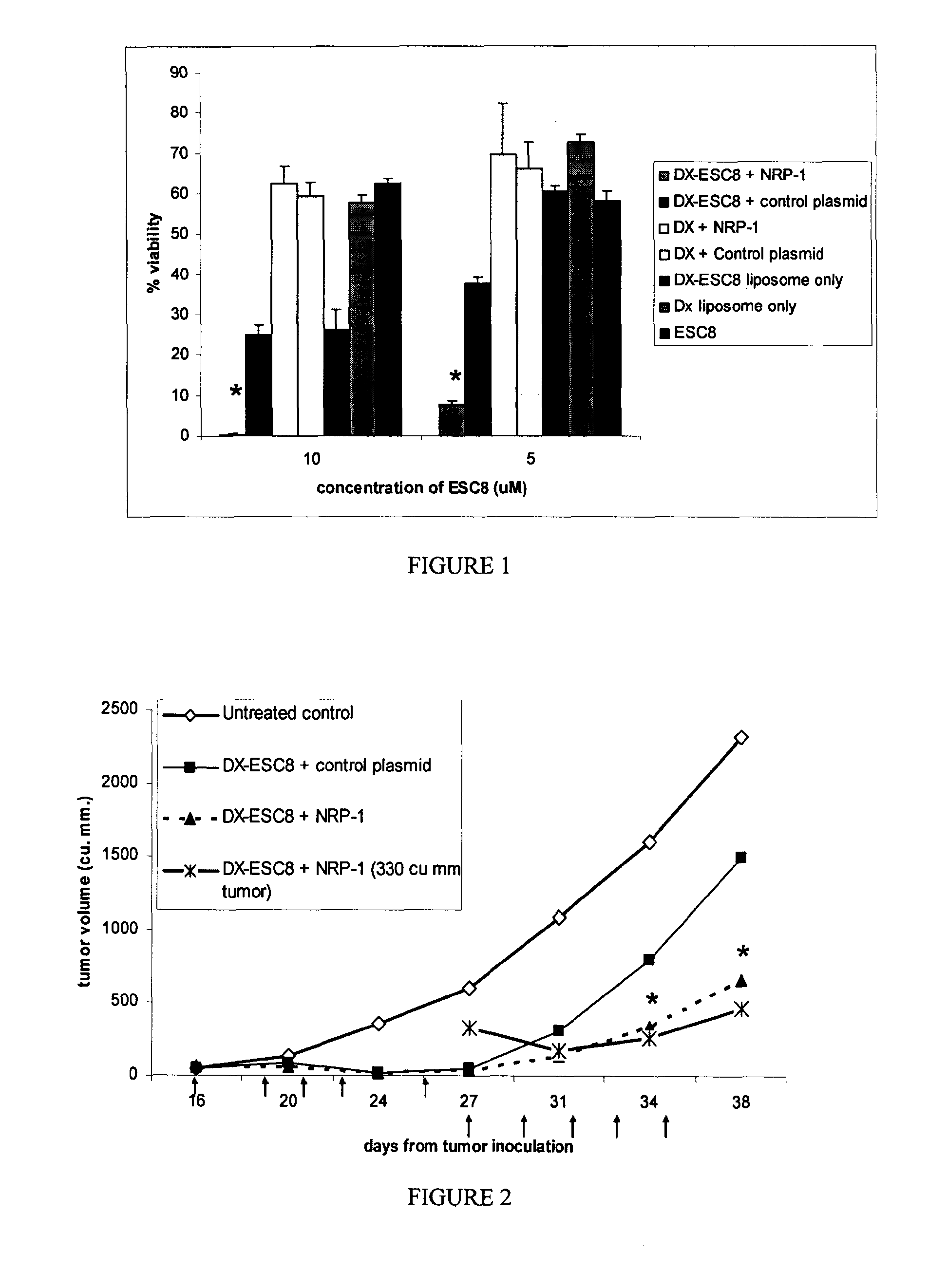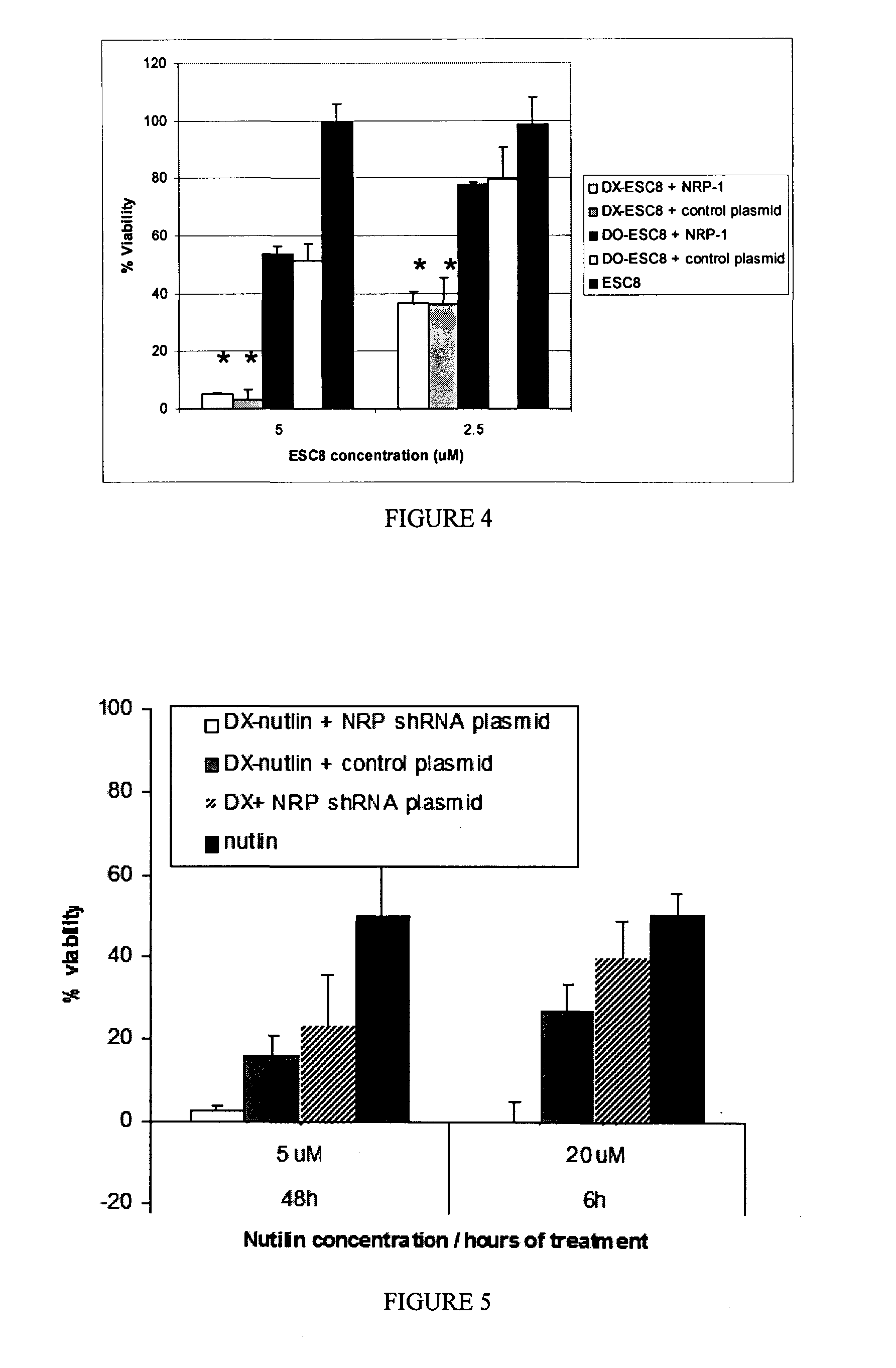Synergistic Anti-cancer composition and a process for the preparation thereof
- Summary
- Abstract
- Description
- Claims
- Application Information
AI Technical Summary
Benefits of technology
Problems solved by technology
Method used
Image
Examples
example 1
Preparation of Liposome Formulation and Complexation with NRP-1 ShRNA Plasmid
[0089]DODEAC (N,N-dihydroxyethyl N,N-dioctadecyl ammonium chloride, the cationic lipid) (0.645 μg), cholesterol (the co-lipid) (0.386 μg), dexamethasone (another co-lipid and a GR-targeting synthetic ligand) (0.294 μg) and ESC8 (anti-cancer drug) (151 μg) were premixed in a molar ratio of 1:1:0.75:0.25 in chloroform and methanol (4:1 v / v) (1 ml). The organic solvent was removed under a thin flow of dry air / N2 to get a thin layer of lipid film. The lipid film was further dried under high vacuum for 5 hrs at 27° C. The dried film was hydrated using 1 ml 5% glucose solution and kept overnight at room temperature. The solution was vortexed and then sonicated under titanium probe at a continuous output level of 4 for a total of 3 minutes or more until all the lipids are suspended in solution with intermittent stops of 5 seconds after every 16 seconds of sonication. The resulting liposome formulation was named DX...
example 2
Preparation of DX-Nutilin Liposome Formulation and Complexation with NRP-1 ShRNA Plasmid
[0090]DODEAC (N,N-dihydroxyethyl N,N-dioctadecyl ammonium chloride, the cationic lipid) (645 μg), cholesterol (the co-lipid) (386 μg), dexamethasone (another co-lipid and a GR-targeting synthetic ligand) (294 μg) and nutilin (anti-cancer drug) (154.4 μg) were premixed in a molar ratio of 1:1:0.75:0.25 in chloroform and methanol (4:1 v / v) (1 ml). The organic solvent was removed under a thin flow of dry air / N2 to get a thin layer of lipid film. The lipid film was further dried under high vacuum for 5 hrs at 27° C. The dried film was hydrated using 1 ml 5% glucose solution and kept overnight at room temperature. The solution was vortexed and then sonicated under titanium probe at a continuous output level of 4 for a total of 3 minutes or more until all the lipids are suspended in solution with intermittent stops of 5 seconds after every 16 seconds of sonication. The resulting liposome formulation wa...
example 3
In-Vitro Cell Culture Study
[0091]Cancer cells (ANV-1, PANC-1, ASPC-1) were inoculated at a concentration of 5000 cells / well of 96-well cell culture plates in 10% Fetal Calf serum (FCS) containing DMEM media. Following an incubation of minimum of 16 h at 37° C., the cells were treated in triplicate with respective lipoplexes (DX-ESC8, DO-ESC8, DX,) pre-complexed with 0.3 μg of NRP-1 or control plasmid amounts per well as discussed in Example 1. The cells were also treated with naked liposomes with or without ESC8 or free drug, ESC8, in a final volume of 300 μl (volume made up with 10% FCS containing DMEM media) continuously for 48 h (mostly) or 72 h. The test solutions were picked from the following list: a) DX-ESC8 pre-complexed with 0.3 μg of NRP-1 Sh-RNA plasmid, b) DX-ESC8 pre-complexed with 0.3 μg control plasmid, c) DO-ESC8 with 0.3 μg NRP-1 Sh-RNA plasmid, d) DO-ESC8 with 0.3 μg control plasmid, e) DX liposome pre-complexed with 0.3 μg NRP-1 Sh-RNA plasmid, f) DX liposome pre-...
PUM
| Property | Measurement | Unit |
|---|---|---|
| Temperature | aaaaa | aaaaa |
| Temperature | aaaaa | aaaaa |
| Temperature | aaaaa | aaaaa |
Abstract
Description
Claims
Application Information
 Login to View More
Login to View More - R&D
- Intellectual Property
- Life Sciences
- Materials
- Tech Scout
- Unparalleled Data Quality
- Higher Quality Content
- 60% Fewer Hallucinations
Browse by: Latest US Patents, China's latest patents, Technical Efficacy Thesaurus, Application Domain, Technology Topic, Popular Technical Reports.
© 2025 PatSnap. All rights reserved.Legal|Privacy policy|Modern Slavery Act Transparency Statement|Sitemap|About US| Contact US: help@patsnap.com



